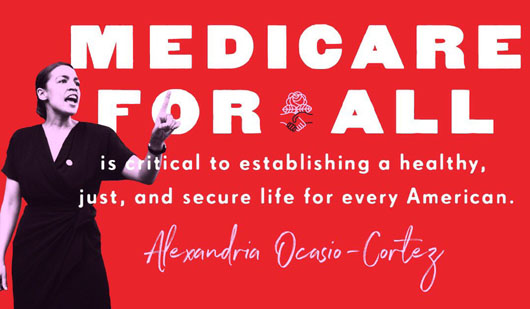Special to WorldTribune, September 6, 2018
By Bruce Schlesman
American politics has added a new face to propagate the same bad old ideas. Add to that a new slogan: “Medicare For All”.

Alexandria Ocasio-Cortez sent shockwaves through the United States when she upset the heavily-favored Joe Crowley, an important democrat congressman, in a Brooklyn, New York district. Instantly, it drew comparisons to the Cantor-Brat upset in 2014 in my home district near Richmond, Virginia. Eric Cantor was an establishment Republican many favored to win speaker. Instead, he lost his primary to Dave Brat, an economics professor at a local college running as a Tea Party conservative.
Ocasio-Cortez has recently achieved celebrity status as many progressives have fallen in love with the socialist platform she ran on. In many ways, she has become the new face of American socialism.
“Medicare for All” is the progressives’ new focal point. It’s a bill proposed by Bernie Sanders and Elizabeth Warren and defended by Ocasio-Cortez.
In its essence, the bill seeks the expansion of Medicare into a universal, single-payer healthcare system. Sanders and Ocasio-Cortez seek to emulate Europe by establishing an American universal healthcare system.
The bill seeks to eliminate people’s need to pay for their own healthcare as so many Americans find themselves unable to pay for adequate medical care. This “free” healthcare would be available to everyone, including those with preexisting conditions. Sanders claims that 29 million Americans are without health insurance and this bill would provide them with healthcare, free of cost.
The philosophy of socialized medicine aside, this bill would have some glaring flaws. Chief among them, there is no feasible way to pay for this healthcare plan. Free is never free, after all.
According to estimates in an independent study, Medicare for All would cost a whopping 33.2 trillion dollars over ten years. To compare, the total American debt is currently over 21 trillion dollars. How in the world does the Left plan to pay for this healthcare plan?
Ocasio-Cortez tried to argue cuts in American defense spending would be enough to pay for the plan. The United States government currently spends 590 billion dollars on defense and its total budget in 2017 was 4 trillion dollars. Medicare for All would cost the United States 3.2 trillion dollars a year, a number almost equaling the total budget.
If the entire U.S. military was eliminated to pay for Medicare for All, it would still cost an extra 2.6 trillion dollars. In this fantasy world where that’s on the table, the U.S. would have to add 2.6 trillion dollars a year, in addition to the 700 billion deficit that already exists, to the national debt even if defense spending is eliminated entirely.
Ocasio-Cortez has further argued the plan would save more money than it spent. She pointed to a study concluding that it would cost 2 trillion dollars less than the current amount spent on healthcare in the United States because cost to providers would be magically slashed by 40 percent as part of Medicare for All.
That study actually said the cost would be 32.6 trillion dollars to the federal government even with provider costs being slashed. Without the provider costs, the plan would cost 40 trillion. However, neither Sanders nor Ocasio-Cortez has indicated how the bill would go about slashing provider costs.
Of course, not even Ocasio-Cortez would be willing to push for the dissolution of the American military to pay a part of her insanely expensive agenda. Instead, she and Sanders shy away from the hard questions. They don’t concern themselves with the details and instead focus on pushing the message of “free universal healthcare for all.” This bill is the ideological equivalent of an average, middle class American making $50,000 a year arguing that if they cut out going to the movies, they will finally be able to afford a private jet.
Of course, the bill won’t be free; it will be paid for in massive tax raises. For Medicare for All to be feasible, progressives would need to more than double tax revenue in the United States. After all, they would need to fund a 3.2 trillion dollar a year program (unless they slash government spending to the bone to make room for it). Sanders proposed his own options on how to fund his high cost program. They include a 7.5 percent income tax increase, increasing the death tax, up to a 52 percent increase on taxes on the rich, increased capital gains taxes, increased taxes on businesses, and decreasing available tax deductions. However, even if every one of Sanders’ tax increases were passed, it would represent a 16 trillion-dollar revenue increase over 10 years, half the amount needed to fund Medicare for All without extreme budget cuts.
Sanders’ suggested cocktail of punitive tax increases only reaches the halfway point. That is a terrifying thought, considering the economic consequences such a sharp tax increase could have on our GDP and average Americans’ wallets.
The numbers simply put, are not on the side of Medicare for All.
Bruce Schlesman is a former campaign staffer currently pursuing a Master’s in Public Policy and International Affairs at Liberty University.
